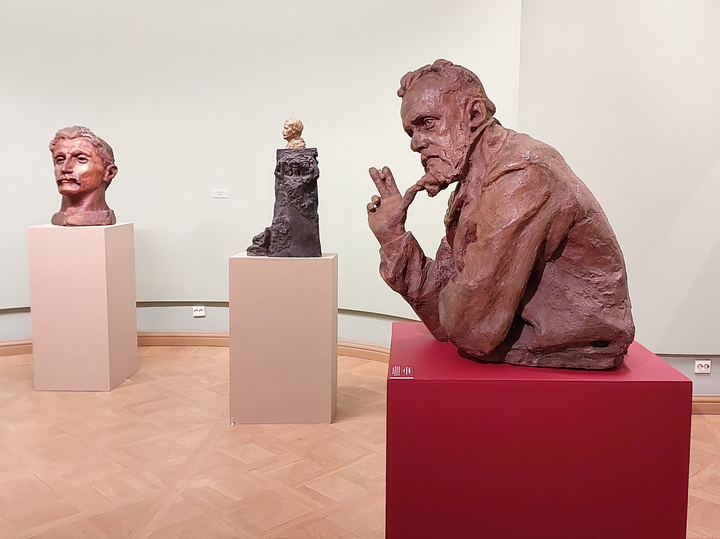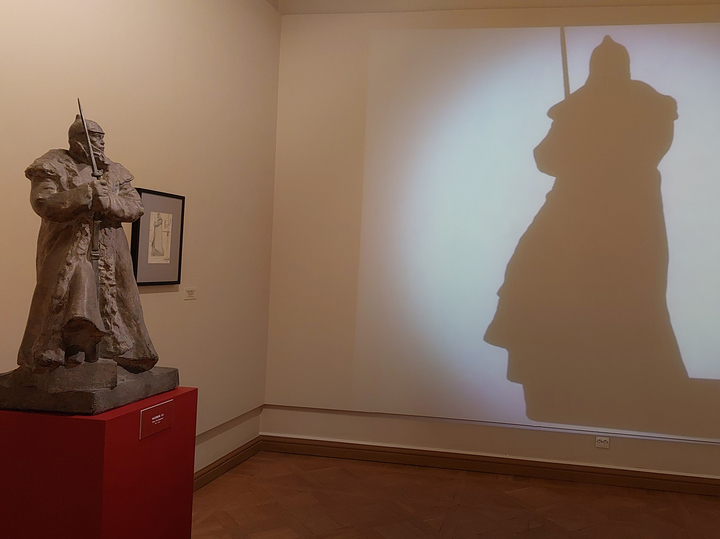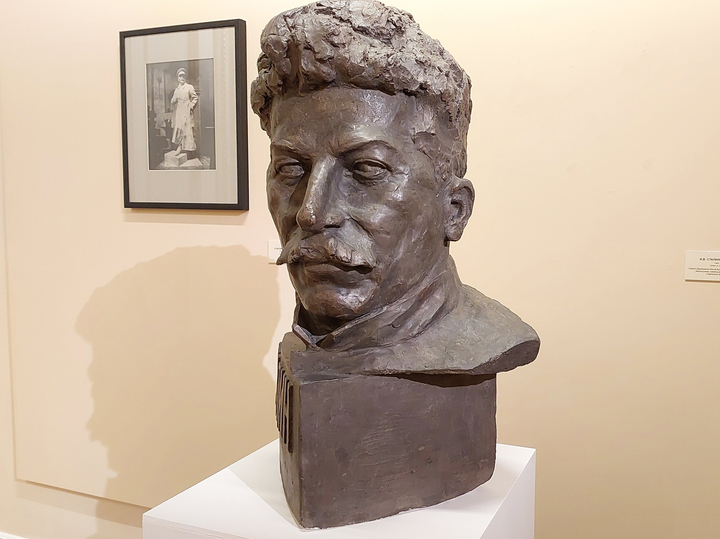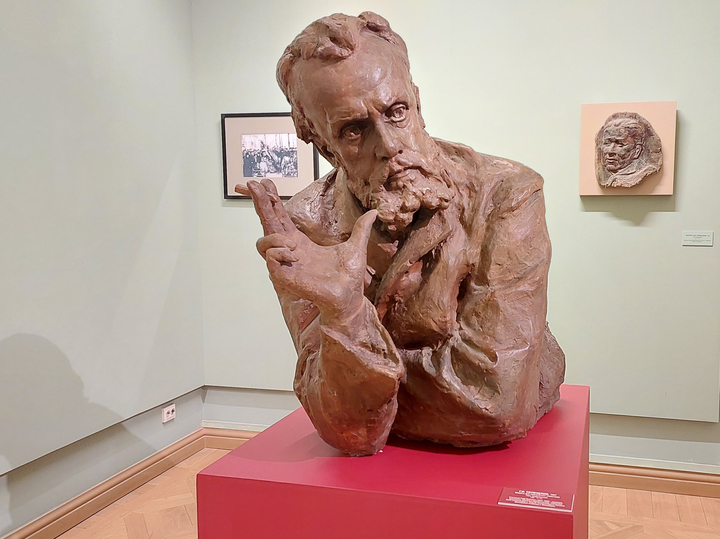Sculptor Leonid Sherwood received a ration instead of the Stalin Prize
[ad_1]
The fate of her grandfather is such that you can shoot a movie, a detective series. Each fact raises questions, each work presents a riddle. Much of his heritage is irretrievably lost. How could it happen that the most glorious family actually fell into oblivion.
Leonid Sherwood was born in 1871 in Moscow into a large family of academician of painting, architect Vladimir Sherwood, the same one who created the building of the Historical Museum on Red Square.
In his youth, the son studied in his father’s workshop, then at the Moscow School of Painting, Sculpture and Architecture. Later he moved to St. Petersburg, entered the Higher Art School at the Academy of Arts, where he met Anna Golubkina and Sergei Konenkov. Their trinity was called “restless Muscovites”, and there were reasons for this.
On the Internet you can find a modern film script about Golubkina, where Leonid Sherwood is present as a character, speaks with quotes from his own book. From 1916 to 1918 he was a restorer in the Hermitage. And these are the years of the war, when there were no orders. Thank you for helping me find a job. Leonid Sherwood died on August 23, 1954 and was buried at the Literary bridges of the Volkovsky cemetery.
His exhibition presents the pre-revolutionary period. This is a portrait of Pushkin in 1902, a plaster model of the gravestone of the writer Gleb Uspensky in 1909 on Literatorskie Mostki.
A circle of youth gathered in his house, and, according to Sherwood’s memoirs, it was a place of internal self-development. By 1910, the snow-white bas-relief “The Kiss”, made of plaster, depicting a vase of flowers and two nude figures – a woman and a man kissing her hand – dates back to 1910. This is a work from the collection of the sculptor’s granddaughter. Nearby on the wall is another Kiss, also from 1910, but made of marble, without a vase, with naked half-figures of the same woman and a man kissing her hand.
“Kiss” and figurine “Angel” – from the personal collection of Olga Sherwood, they passed to her from her parents. “The Kiss” was restored in 2000 by the restorer of the Russian Museum.
“He hangs on my wall,” says Olga Sherwood. – I have seen him all my life, but on the museum wall he makes a completely different impression.
The “kiss” was made as a wedding gift to a naval officer and future Rear Admiral Vsevolod Evgenievich Yegoriev, whose father was the commander of the cruiser Aurora and died in the Battle of Tsushima. Since they were relatives and friends, my grandfather made a “Kiss” as a gift in 1910.
I tried, but did not find the descendants of Yegoriev. And here is the mystery. If the grandfather prepared a gift, he should have given it. Another question arises: why does the Russian Museum have the same “Kiss” in marble and only half of the figures?
Each exhibit has its own mysterious story. “Angel” stood on our wardrobe all my life, and I called the figurine “Wind”. The curator of the exhibition, Elena Veniaminovna Karpova, found a mention of him in the catalog of some exhibition in 1906.”
A plaster version of the bust of Fyodor Stravinsky, Honored Artist of the Imperial Theatres, opera singer and father of composer Igor Stravinsky, created in 1916, is also presented in the Mikhailovsky Castle. Its marble counterpart is installed in the foyer of the Mariinsky Theatre.

The model of the bust of Mikhail Vrubel for the tombstone from the collection of the Russian Museum dates back to 1917. The project was not implemented, just as the projects of monuments to Peter I, actress Vera Komissarzhevskaya were not implemented. Many of the interiors created by Leonid Sherwood have not been preserved, in particular, the building of the Volga Insurance Company on Kazanskaya Street in St. Petersburg.
In Soviet times, the sculptor Leonid Sherwood participated in the implementation of the monumental propaganda plan, created monuments to Radishchev and Herzen. Among the works of that time are busts of Anatoly Lunacharsky, Stalin, Lenin, chemist Dmitry Mendeleev.

A landmark work and one of the first works of socialist realism is the monumental statue of the “Sentinel” of 1932. She has an amazing destiny. In 1931, under an agreement with the Revolutionary Military Council, Sherwood was supposed to create a sculptural group “Cultural rest of the Red Army”, but instead appeared “Sentinel”. His cement figure was installed in 1933 at the entrance to the exhibition “15 Years of the Red Army” in Moscow. Then she exhibited in Leningrad, Kyiv, Kharkov.
In 1937, Sherwood headed the sculpture department at the Kiev Art Institute and taught there until 1940. And in 1941, he recreated the Sentry for the Tretyakov Gallery. In 1959, by order of the Tretyakov Gallery, the figure was re-cast in bronze (master V. Lukyanov). In 1961, it was installed at the entrance to the gallery in Lavrushinsky Lane. Since 1992, the sculpture has moved to the Muzeon Park of Arts near the New Tretyakov Gallery.
In addition to exhibits from the collection of the Russian Museum, Mikhailovsky Castle presents works from other museum and private collections, documents, including a letter from the son of the writer Gleb Uspensky to Leonid Sherwood, a photograph of the sculptor with his wife Olga Gakkel, his application to the factory management of the porcelain factory, photographs of monumental works, including lost.
The authors of the exhibition have done a lot of research to reproduce the biographical facts, the history of the appearance and creation of some of the sculptor’s works. Much has been lost. For example, a bronze bust of Alexander III, “Forging Peter” and the composition “Dying Susanin” of 1943. The plaster half-figure “Tolstoy Thinker” was broken in 1957, and the diploma work “The Despot Tatar and His Slave”, kept in the Pskov Museum, disappeared during the Great Patriotic War. For this work, Sherwood in 1898 received the right to travel abroad and visited Warsaw, Vienna, Munich, Venice, Rome, Paris.
Leonid Sherwood participated in competitions more than once, but his bright projects did not win. In 1914, he created a project for a monument to Taras Shevchenko in Kyiv, which, according to the jury, claimed the first place. However, the organizing committee preferred the sculpture of the Italian Sciortino to him, after which several members of the jury left his ranks in protest.
To our question about why Leonid Sherwood was hardly remembered for 70 years, Olga Sherwood answered: “A mysterious story. It would seem that the famous family. My great-grandfather Vladimir Sherwood built the building of the Historical Museum. He had two more architect sons who built many houses and churches in Moscow. Nephew Nicholas Sherwood built the Swallow’s Nest. They are forgotten.
About 15 years ago, the Historical Museum published a book about the Sherwood dynasty in the context of the history and culture of Russia, which mainly deals with the great-grandfather, but there is an article about the grandfather written by the head of the Russian sculpture department of the Russian Museum, Elena Karpova, who became the curator of the current exhibition.
I spent five years in the archives and did not find anything to confirm the possibility of oblivion. There is no hint of specific things why everything happened this way. Grandfather was appreciated by Repin, and he was Repin, although he was not his direct student. Repin promoted his academicians, but his grandfather did not become an academician. During his career, he received only the title of Honored Artist. And for some reason he did not receive the Stalin Prize, although the Stalin Committee, which met in 1943 at the Bolshoi Theater, voted in favor.
I saw documents where his candidacy was crossed out with a pencil, and the next paragraph was the words: “Please give him a ration.” Rations instead of the Stalin Prize!
There is a family legend that my father never told me about, and it is connected with Lunacharsky. Either he, or someone from his entourage agitated grandfather to join the party, but he never joined its ranks. Maybe for this reason everything happened in his fate.

The exhibition presents models of monuments to Stalin and Lenin at the Finland Station. And they weren’t installed. The only monument that was erected back in tsarist times was to Admiral Makarov in Kronstadt. “While working in the archives of the Navy, I read the letters of officers and sculptors, which said that this is a good monument, why put it in Kronstadt, it is better to install it in St. Petersburg,” says Olga Sherwood. – The whole fleet collected money for him, because Makarov was very loved.
Another inexplicable thing is connected with the fact that there are few documents left from the grandfather. In the pre-revolutionary archive of the Academy of Arts, other students have detailed personal files, and the grandfather has 5-6 documents, no report card, no grades. Each of his Pushkins, and there were three of them, caused a scandal.
The 1902 bust of Pushkin caused a scandal at the Academy of Arts because it was not canonical. Grandfather participated in two Pushkin competitions – in the one where Opekushin won, whose monument stands in Moscow, and in the post-war one, where Anikushin won, and his wonderful Pushkin stands in St. Petersburg on Arts Square. Grandfather presented Pushkin with a torch to this competition, for which he was accused of formalism.

Working in the archives, I found references to more than 120 works, some of them are in the Russian Museum, something with relatives. About thirty works have survived only in the form of images. But there isn’t much at all.
It turns out that the manuscripts do not burn, and the sculptures disappear. The world of sculpture has just opened up for me. I read the pre-war orders received by the Leningrad Regional Union of Soviet Artists – LOSSHA, which indicated who and whom will be sculpted. Stalin – so much, Lenin and Kalinin – so much. There were orders for the anniversary of October and Lenin’s birthday.
It is also interesting what kind of paper they wrote on before the revolution and then on some scraps. The course of history can be felt by the quality of the paper. I understood who Akaki Akakievich Bashmachkin was and a lot about bureaucracy, otherwise I began to perceive the 19th century and how people lived then differently.
Collected a lot of invaluable materials. It would be nice to publish them. These are invaluable evidence of the life of not only a particular master and his glorious family, but of an entire era, history as such.
[ad_2]
Source link






